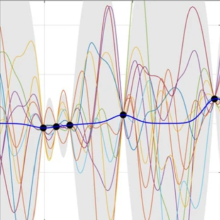New SFB 1313 publication, published in the scientific journal Transport in Porous Media. The work has been developped within the SFB 1313 research projects B04 and B05.
“Optimal Exposure Time in Gamma-Ray Attenuation Experiments for Monitoring Time-Dependent Densities”
Authors
- Ana Gonzalez-Nicolas (University of Stuttgart)
- Wolfgang Nowak (University of Stuttgart, SFB 1313 research projects B04 and B05)
Abstract
Several environmental phenomena require monitoring time-dependent densities in porous media, e.g., clogging of river sediments, mineral dissolution/precipitation, or variably-saturated multiphase flow. Gamma-ray attenuation (GRA) can monitor time-dependent densities without being destructive or invasive under laboratory conditions. GRA sends gamma rays through a material, where they are attenuated by photoelectric absorption and then recorded by a photon detector. The attenuated intensity of the emerging beam relates to the density of the traversed material via Beer–Lambert’s law. An important parameter for designing time-variable GRA is the exposure time, the time the detector takes to gather and count photons before converting the recorded intensity to a density. Large exposure times capture the time evolution poorly (temporal raster error, inaccurate temporal discretization), while small exposure times yield imprecise intensity values (noise-related error, i.e. small signal-to-noise ratio). Together, these two make up the total error of observing time-dependent densities by GRA. Our goal is to provide an optimization framework for time-dependent GRA experiments with respect to exposure time and other key parameters, thus facilitating neater experimental data for improved process understanding. Experimentalists set, or iterate over, several experimental input parameters (e.g., Beer–Lambert parameters) and expectations on the yet unknown dynamics (e.g., mean and amplitude of density and characteristic time of density changes). We model the yet unknown dynamics as a random Gaussian Process to derive expressions for expected errors prior to the experiment as a function of key experimental parameters. Based on this, we provide an optimization framework that allows finding the optimal (minimal-total-error) setup and demonstrate its application on synthetic experiments.

Holger Steeb
Prof. Dr.-Ing.Spokesman, Principal Investigator, Research Projects B05, C05, and Z02, Central Project Z

Wolfgang Nowak
Prof. Dr.-Ing.Principal Investigator, Research Projects B04 and B05


